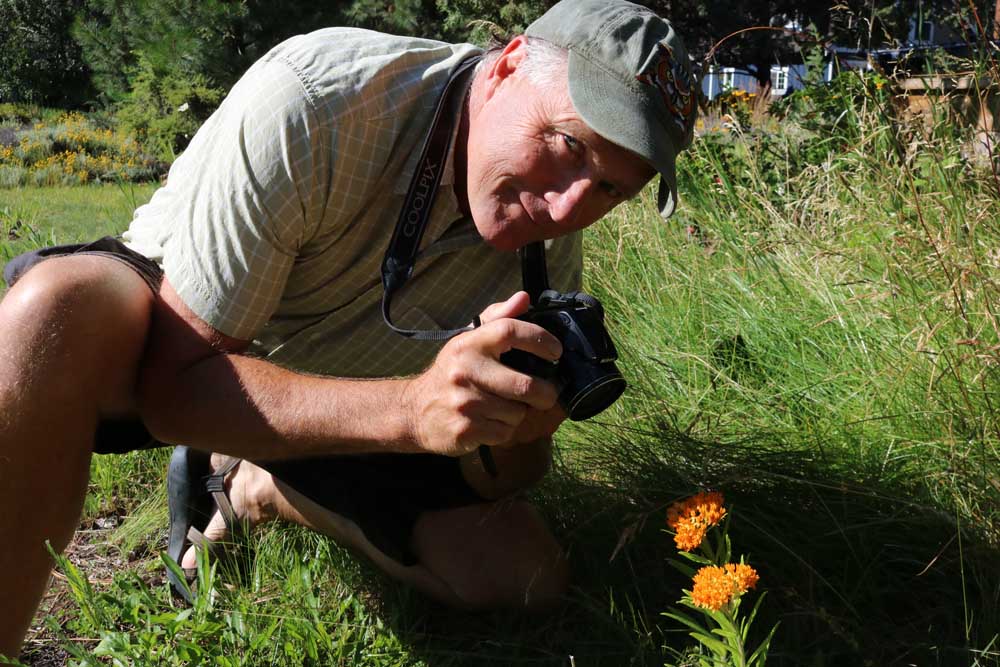Bend writer highlights Oregon’s flower power
Published 12:00 am Thursday, August 1, 2019

- Naturalist and writer Damian Fagan photographing Butterfly Milkweed.(Submitted photo)
Every wilderness fanatic or casual day hiker enjoying Oregon’s nature trails has noticed a beautiful flower or unusual plant somewhere along their journey and wondered, “What is that?”
“Wildflowers of Oregon: A Field Guide to Over 400 Wildflowers, Trees, and Shrubs of the Coast, Cascades, and High Desert,” is a new field guide by Bend naturalist, writer and photographer Damian Fagan that can help answer that question. Fagan will discuss his book at an event Aug. 10 at Roundabout Books in Bend.
“Wildflowers of Oregon” is a paperback guide that uses color photographs and some of the most recently updated technical botanical data to identify the most common (and some rarer) flowering plants found across Oregon. The book is organized into six chapters based on each flower’s color, making it easy for non-botanists to use. Within each color grouping, plants are then ordered alphabetically by their scientific family name while also listing their most widely-used common name. Each entry includes a color photograph, short physical description of the plant and its key characteristics, plus details about its bloom season, habitat and range.
“I also try to include information with each of the plant descriptions that I think people would find interesting,” Fagan said. “Maybe it’s what the scientific name means when you break it down, or comments about the edibility or a unique pollinator for the plant. I think these naturalist tidbits help make it more memorable, rather than spending so much time describing the plant’s appearance. I let the photograph tell more of that story.”
When Fagan was asked by publisher FalconGuides to write the book as part of its new state specific series of wildflower guides, he realized he had a sizable challenge. Due to the planned page count of “Wildflowers of Oregon,” Fagan had to select just over 400 of the state’s roughly 3,000 flowering native plants to be featured in the book.
“I was trying to find a bit of representation from all the regions of Oregon, but I had to exclude some groups of plants,” Fagan said. “So there are no conifers, and I only featured a couple of flowering trees and small selection of shrubs. I focused more on common wildflowers and also tried to put in a few unusual or rare plants.”
Fagan had about a year starting in September 2017 to find and document all the wildflowers he wanted to include. He was able to use some of the research and photographs of plants from one of his previous guides, “Pacific Northwest Wildflowers,” and spent around 75 days in the field searching for and photographing his remaining subjects. But despite his careful planning, there were a number of plants on his wish list that still didn’t make it into the book.
“I had some on my target list, but I just couldn’t find them, or by the time I got to them, they were past their prime or no longer blooming,” Fagan said. “During wildfire season, some days were just too smoky to go shoot photos, so I was trying to get really tight closeups or had to come back after fire season and hope I could still find them.”
Fagan also decided to exclude some endangered plants and plants found in sensitive habitats that could be damaged by people searching for them.
The writer turned to technology to help find and identify some of the plants in the book. He checked social media groups such as the Oregon Wildflowers Facebook group for information about recent sightings of the plants he was hunting. He also used the Oregon Wildflowers app developed by Oregon State University’s Oregon Flora Project.
One of the other challenges facing anyone writing a botanical guide or field guide to flora, is that while the scientific or Latin names for plants are fairly set, there are not always standard common names for those plants. In some cases this means a single plant can be known by several different standard names, causing difficulty organizing the plants within the book.
“There’s not an overarching organization that sets the standards for the common names of plants in the U.S.,” Fagan said. “Even many of the scientific names have changed over time. Recently, researchers studying certain plant families will break them out into more subgroups, adding to the confusion.”
Fagan says 2019 in Oregon has been a great year for flowers due to the cooler and wetter weather experienced in many parts of the state during winter and spring. At elevations from around 5,000 to 8,000 feet near Central Oregon, hikers should be able to see blooming lupine, lilies, paintbrush, larkspur, cow parsnip, columbines and more. But even though he’s now authored four field guides (three of them focused on wildflowers), he doesn’t think of himself as the voice of authority on the subject.
“Although I have a botany degree and have written several of these guides, I don’t call myself an expert,” Fagan said. “I call myself a plant enthusiast, because while I know a fair bit about it, I certainly don’t know everything about all 3,000 flowering plants here. As soon as you call yourself an expert, someone’s going to ask a question you can’t answer and bring you right back down to earth.”






